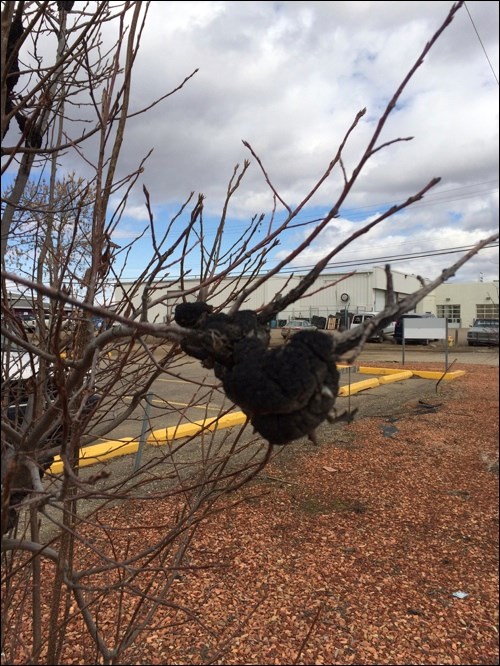Even bad things sound better if you say them in French. In fact sometimes just the sound of it, said in the language of love, almost makes you wish you had some. In Latin it becomes irresistible. Dibrotryon morbosum. Ooooo la la, where can I buy this, I gotta get some for the yard. Don’t buy it. It comes to your yard for free.
If you have chokecherry, mayday, Schubert chokecherry or plums you may have noticed a hard, black yucky mass of growth on some branches or on lots of branches or maybe even in the main stem. It resembles, well, poop. But we know that most dogs don’t climb trees, so it has to be something else.
It is the dreaded black knot disease. It has been rampant in the Battlefords for a few decades now. If left unchecked it will likely kill the tree.
Spring time, before the leaves come out, is a great time to look for these growths. I have a friend in Winnipeg, Man. Mike Allen affectionately known in those parts as Dr. Trees, who wrote a book called Dr. Tree’s Guide to the Common Diseases of Urban Prairie Trees. Of course it’s a bestseller and I’m surprised you’ve never heard of it. The recommended treatment according to Dr. Trees is to remove all the affected limbs making the cut 30 centimetres below the infection site back towards the trunk, preferably at a healthy branch junction. Don’t forget to sterilize your shears between cuts to reduce the chances of the disease being spread by your good intentions.
If the infection site is in the main stem then the future of the tree is a fait a complit (French again, sounds OK but don’t be fooled) it will eventually die. Dr. Trees recommends one pruning cut only if the disease is in the main trunk. This cut should be made at the very bottom and be flush with the ground. Yep, remove the tree and plant something else that is not susceptible to Merde sur un baton. All diseased prunings should be bagged (if practical) and taken to the landfill to prevent the disease from spreading. Do not store and use for firewood.
“How about those French, they have a different word for everything.”
— Steve Martin
Random gardening tip: How do you know if it’s a Dogwood or not? By the bark.



